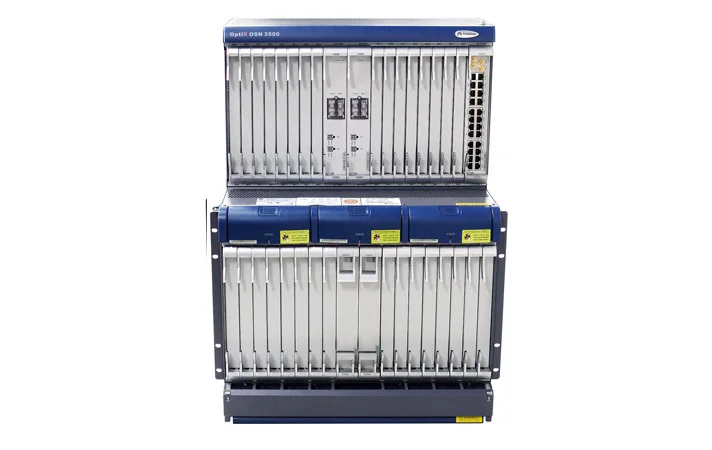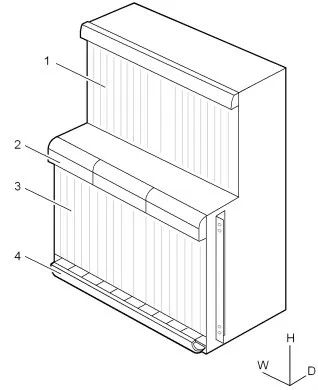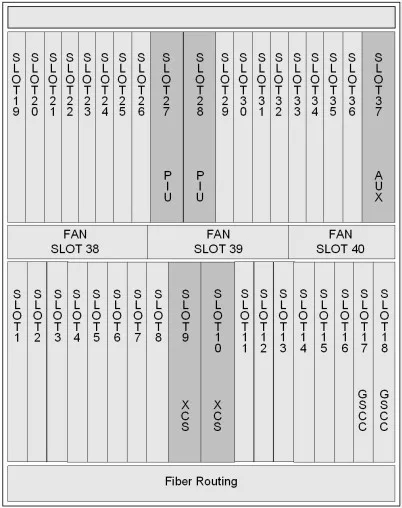- Call us now: 86
- Email: xzh@combasst.com
To meet the growing demands of Metropolitan Area Networks (MANs), Huawei has developed the OptiX OSN 3500—next-generation intelligent optical transmission system. Primarily used at the metropolitan convergence and backbone layer, the OptiX OSN 3500 in
Category: SDH
1.Appearance

2.Structure

| 1. Slot area for interface boards | 2. Fan area | 3. Slot area for processing boards | 4. Fiber routing area |
The functions of these areas are as follows:
- Slot area for interface boards: This area is used to house the interface boards of the OptiX OSN 3500.
- Fan area: This area is used to house three fan modules, which dissipate the heat generated by the equipment.
- Slot area for processing boards: This area is used to house the processing boards of the OptiX OSN 3500.
- Fiber routing area: This area is used to route fibers in the subrack.
3.Slot Allocation
The OptiX OSN 3500 subrack consists of the upper layer and the lower layer. The upper layer, where 19 slots are available, is the slot area for interface boards. The lower layer, where 18 slots are available, is the slot area for processing boards.

Slot Area for Interface Boards
Slots for the interface boards: slots 19-26 and 29-36
Slot Area for Processing Boards
Slots for the processing boards: slots 1-8 and 11-17
Other Slots
- Slots for the cross-connect and timing boards: slots 9-10
- Slots for the SCC boards: slots 17-18 (slot 17 can also house a processing board)
- Slots for the PIU boards: slots 27-28
- Slot for the auxiliary interface board: slot 37
- Slots for the fan boards: slots 38-40
4.Product Feature
Large switching capacity
- 200G high order, 20G low order
High integration
- Subrack dimensions 722mm (H) x 497mm (W) x 295mm (D), 15 slots for processing boards and 16 slots for interface boards
Flexible networking capacity
- Supports Mesh networking with plug-and-play network nodes
- Supports dynamic increase of rate and capacity
- Supports various networking topologies, including chain, ring, tangent rings, intersecting rings, etc
- Supports maximum 2 STM-64 four-fiber MSP rings, 4 STM-64 two-fiber MSP rings, 11 STM-16 four-fiber MSP rings, 12 STM-16 two-fiber MSP rings
Carrier-class protection
- Mesh Protection and restoration(ASON)
- Distributed restorable rerouting protection
- 5-level service dedicated protection scheme based on different SLA: Diamond, Gold, Silver, Copper and Iron services
- SDH Network Protection
- 2/4 fiber MSP Ring; 1+1, 1: n Linear MSP; SNCP/SNCMP/SNCTP; Fiber shared virtual path protection; Fiber shared MSP Ring; DNI (ITU-T G.842)
- Service Protection
- Ethernet: RPR, RSTP
- ATM: VP-RING/VC-RING
Highly reliable design
- 1+1 hot backup for system control boards, cross-connect and synchronous timing boards
- 1+1 hot backup for power supply modules
- Redundancy protection for fan modules
- TPS protection
- 1:n tributary protection for E1/T1/E3/T3/ E4/STM-1(e)/FE
Enterprise-focused Features
- Intelligent ASON based Mesh network can against multi-node failures, improving network reliability by 10 times
- Built-in PCM for real All-in-One solution to access low speed services for enterprise customer
- Single-span transmission for a distance of 270km without a Raman amplifier, fewer REGs to reduce the network construction cost and facilitate the maintenance
- Specified 2M optical interface to support direct connection between MSTP equipment and relay protection device, lower risk and higher reliability
Industry Certification
- Pass EN 50121-4 Railway EMC certification.
| System Features | |||||
|---|---|---|---|---|---|
| Subrack dimensions | 722 mm (H) x 497 mm (W) x 295 mm (D) | ||||
| Switching capacity | Packet: 160 Gbit/s and TDM: 200 Gbit/s (higher order), 20 Gbit/s (lower order) | ||||
| Service slots | 15 slots for processing boards and 16 slots for interface boards | ||||
| Highly reliable design | 1+1 hot backup for power supply modules, system control boards, cross-connect and synchronous timing boards Redundancy protection for fan modules |
||||
| Supported interfaces | Packet transport interfaces | E1, ch STM-1, ATM STM-1, FE/GE/10GE | |||
| MSTP INTERFACES | STM-1/4/16/64, E1/E3/E4/T1/T3, FE/GE/10GE, DDN, IMA/ATM, FEC/EFEC interface, E1 optical interface, SAN, Video | ||||
| PCM interfaces | FXS/FXO, 2/4 wire/E&M V.35/X.21/V.11/V.24/V.28, RS232/422 |
||||
| WDM INTERFACES | 40-channel DWDM interfaces, compliant with ITU-T G.694.1 8-channel CWDM interfaces, compliant with ITU-T G.694.2 |
||||
| Networking Mode | Supporting pure packet,hybrid (packet + SDH) or SDH networking Supporting WDM networking Supporting single-fiber bidirectional transmission |
||||
| Power Supply | -38.4~ -72V DC; 110/220V AC (External module) | ||||
| Operation Environment | Temperature Relative Humidity Long term: 0°C ~ 45°C 10% ~ 90% Short term: -5°C ~ 55°C 5% ~ 95% |
||||
| Packet Transport Features | |||||
| Service features | E-Line and E-LAN QinQ MPLS-TP based VPWS and VPLS Multi-section pseudo-wire (MS-PW) TDM PWE3: CESoPSN and SAToP, compression of idle timeslots ATM/IMA PWE3 ETH PWE3 IGMP SNOOPING V2 Blacklist, Broadcast packet suppression, ACL VLAN SWAP |
||||
| QoS features | Hierarchical QoS scheduling and traffic shaping DiffServ mode based on traffic classification Simple traffic classification, complex traffic classification, per hop behavior (PHB), and ACL Committed access rate (CAR) PQ scheduling priority, weighted fair queuing (WFQ) and PQ+WFQ queuing Tail drop and weighted random early detection (WRED) Eight priority queues Shaping based on port scheduling priority |
||||
| Hardware-based OAM | MPLS OAM | LSP/PW OAM: FDI, BDI CV, FFD, TraceRoute, Ping CES PW VCCV LM, DM |
|||
| MPLS-TP OAM | LSP/PW OAM: CC, LB, LT AIS, RDI LM, DM LCK, TST CSF |
Section OAM: CC, LB RDI LM, DM LCK, TST |
|||
| Ethernet OAM | ETH-CC(Continuity Check),ETH-Loopback,ETH-Link Trace Remote Loopback,Remote Fault Detection |
||||
| ATM OAM RMON(RFC 2819) Flexible design with multiple protocols |
|||||
| Carrier-class protection | LSP/PW Linear protection MPLS-TP Ring protection Anti multifailure protection based on MS-PW Link aggregation group (LAG) protection Multi-chassis link aggregation group (MC-LAG) protection Dual-homing protection LPT STP/RSTP/MSTP IMA protection 1+1 and 1:1 Linear MSP |
||||
| Clock synchronization | Two external clock inputs/outputs (2 MHz or 2 Mbit/s) Two external time signals(1pps+TOD) Adaptive clock recovery (ACR) Synchronous Ethernet IEEE 1588v2 |
||||
| MSTP Features | |||||
| Carrier-class protection | Mesh Protection and restoration(ASON) Distributed restorable rerouting protection 5-level service dedicated protection scheme based on different SLA: Diamond, Gold, Silver, Copper and Iron services SDH Network Protection 2/4 fiber MS-SP Ring; 1+1, 1:n (n<=14) Linear MSP; SNCP/SNCMP/SNCTP; Fiber shared virtual path protection; Fiber shared MS-SP Ring; DNI (ITU-T G.842) Service Protection Ethernet: RPR, RSTP, LAG/DLAG/PPS/BPS ATM: VP-RING, PPS/BPS Electrical Interface Protection 1:N tributary protection for E1/T1, E3/T3, E4, STM-1(e) and FE |
||||
| Multi-service Transport Features | Ethernet Over SDH GFP/LAPS/VCAT/LCAS L2 switch, 64 aggregation directions for powerful Ethernet convergence Mapping granularity, VC-12-nv/VC-3-nv, and VC-4-nv Point to Point LPT, Point to Multi-point LPT MPLS and Stackable VLAN for L2 VPN 4/8-level CoS, CAR based on 64K granularity IEEE 802.3ah, 802.1ag RPR Automatic topology discovery 3-level CoS , A(A0/A1) / B(B-CIR/B-EIR) / C Steering/Wrapping/Steering + Wrapping protection scheme guarantee 50ms switching Spatial reuse of bandwidth with fairness algorithm Integrated MPLS with RPR to provide VLL/VPLS service ATM Support 2M, 34M, 155M, 622M ATM and IMA E1 support up to 93 IMA group & 189 E1s Others Support FC/ESCON/DVB-AS/ HD-SDI/SD-SDI Support DDN(Nx64K) and Framed E1 |
||||
| Clock synchronization | Two external clock inputs/outputs (2 MHz or 2 Mbit/s) Line clock source Tributary clock source |
||||


